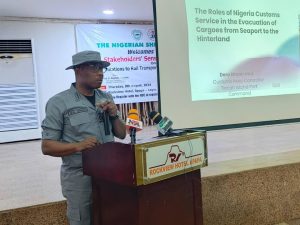

The Roles of Nigeria Customs Service in the Evacuation of Cargoes from Seaport to the Hinterland by CUSTOMS AREA CONTROLLER TCIP DA NNADI mni

This paper examines the pivotal roles played by the Nigeria Customs Service (NCS) in the efficient evacuation of cargoes from seaports to the hinterland. It highlights the benefits of decongesting seaports, the crucial function of escort customs officers in ensuring secure transit to bonded terminals, and the collaborative efforts required among terminal operators, stakeholders, and logistics partners to optimize the evacuation of cargo with the aim of decongesting Seaport and improve overall operational efficiency.
Introduction
Cargo evacuation from Customs Ports to the hinterland is essential for the smooth operation of international trade. Nigeria’s trade and logistics sector is part of this chain. The NCS plays a critical role in this process, ensuring that cargoes are cleared, secured, and transported efficiently. This paper explores the various roles of the NCS in this context, emphasizing the importance of decongesting seaports, the role of escort customs officers, and the collaborative efforts needed to optimize cargo clearance. The NCS roles in this regards is complimented by other parties involved in cargo evacuation from the seaports especially for cargoes destined for the hinterlands and the inland countries.
ROLES OF NIGERIA CUSTOMS SERVICE (NCS)
The NCS is pivotal in ensuring the seamless evacuation of cargoes from seaports to the hinterland. It is in this regard that the Service recognize and license off dock terminals and inland container terminals as provided in Section 31 subsection 2-6 of the NCSA 2023. Other sections of the NCSA 2023 to the evacuation of cargoes to hinterland include Section 121sub sections 2-4 for the admission of goods into a warehouse, 122 subsections 1-6 for bonded terminals, Section 153 being the law guiding management of transire.
Customs Operational Activities in the Movement of Cargo to the hinterland.
Customs Clearance: NCS Officers inspect and verify cargoes to be transferred to the bonded terminals and hinterlands outside the mother port using the IM 8 import module. IM 4 module is deployed for cargo evacuated to bonded terminals under the control of the mother port while IM 5 module is deployed for cargo evacuated to the free trade zones.
These cargoes are evacuated by road or by barge through the waterways and sometimes by rail.
The cargo are escorted by officers who obtain landing certificate. Officers ensure compliance with regulatory requirements, collect duties and taxes, and facilitate the timely release of goods thereafter.
Other incentives introduced by NCS to ease evacuation cargoes include deployment of Fast Track and the Authorized Economic Operators (Section 108 of NCSA 2023) program, the introduction of pre-arrival assessment Report (PAAR) and the pre-release regime which has been has been effective in the facilitation of timely release of cargo for qualified traders.
Others are Risk Management through which the NCS employs techniques to identify and manage potential risks associated with cargoes. One of these is the recently launched World Customs Organization Time Release Study aimed at identifying bottlenecks in clearance process in line with Section 32 of the Nigeria Customs Service Act (NCSA) 2023 and Article 7 of the Trade Facilitation Agreement. This involves adopting modern trends like the Non-intrusive inspections Technology and Tracking shipments, Fast track and Authorized Economic Operator Programs which helps in streamlining the process and reducing delays.
Decongestion Efforts: By implementing streamlined procedures and expediting the clearance process using Inland Container Depots (ICDs), the NCS plays a crucial role in reducing port congestion, which in turn improves the overall efficiency of port operations.
Escort Services: Escort customs officers ensure the secure transit of goods from seaports to bonded terminals in the hinterland. They prevent theft and tampering, maintaining the integrity of the supply chain.
ROLES OF OTHER PARTIES INVOLVED IN CARGO EVACUATION
Bonded Terminal Operators
The Bonded Terminal operators are responsible for the efficient management of port facilities, which directly impacts the evacuation of cargoes:
i. Cargo Handling: Terminal operators manage the loading, unloading, and storage of cargoes. Efficient cargo handling is vital to prevent delays and ensure that goods are moved swiftly through the port.
ii. Coordination with Customs: Effective communication and coordination with the NCS are essential for smooth customs clearance and the timely evacuation of cargoes. Terminal operators must ensure that their operations align with customs requirements.
iii. Infrastructure Management: Maintaining port infrastructure is critical for efficient cargo handling and storage. Well-maintained facilities help in reducing delays and improving the overall flow of goods.
Importers and Exporters
Importers and exporters play a key role in ensuring the smooth evacuation of cargoes from seaports:
i. Documentation: Accurate and complete documentation is essential for customs clearance. Importers and exporters must ensure that all necessary paperwork is in order to avoid delays.
ii. Compliance: Adherence to customs regulations and guidelines is crucial. Non-compliance can lead to penalties and delays, disrupting the flow of goods.
iii. Coordination with Logistics Providers: Making arrangements for the timely transportation of goods from the port to their final destinations is essential. Importers and exporters must coordinate effectively with logistics providers to ensure smooth transit.
Shipping Companies
Shipping companies contribute to the efficient evacuation of cargoes by:
i. Timely Arrival and Departure: Adhering to schedules is crucial to avoid port congestion. Shipping companies must ensure that their vessels arrive and depart on time to maintain the flow of goods.
ii. Cargo Security: Maintaining the security of cargoes during transit is essential to prevent losses and damages. Shipping companies must implement measures to protect goods from theft and tampering.
iii. Coordination with Port Authorities: Effective coordination with port authorities ensures smooth loading and unloading operations, facilitating the swift movement of cargoes through the port.
Freight Forwarders and Logistics Providers
Freight forwarders and logistics providers play a crucial role in the transportation of goods from seaports to the hinterland:
Transportation Arrangements: Organizing the transportation of cargoes is essential to ensure timely delivery. Regular stakeholder engagement with Logistic companies and transport associations like National Association of Road Transport Owners (NARTO) and Barge Operators who have provided alternatives using waterways to optimize transport routes and schedules.
Customs Brokerage: Assisting with customs clearance by preparing and submitting necessary documentation helps in expediting the process. Freight forwarders often act as intermediaries between importers/exporters and customs authorities.
Supply Chain Management: Ensuring the seamless flow of goods and security through the supply chain involves coordinating with various parties in line with World Customs Organization SAFE Framework of Standards, including the Nigeria Ports Authority, NCS, terminal operators, and transport providers, to optimize logistics operations.
Regulatory Bodies
Regulatory bodies ensure compliance with trade and safety standards, which impacts the efficiency of cargo evacuation:
i. The Standards Organization of Nigeria (SON): Enforcing quality and safety standards for imported and exported goods is essential to ensure that all cargoes meet required regulations.
ii. Nigeria Agency for Food and Drug Administration and Control (NAFDAC): Ensuring that cargoes, especially perishables, meet health and safety regulations is crucial to prevent spoilage and contamination.
Nigeria Agricultural Quarantine Service (NAQS): Overseeing the environmental impact of port operations ensures that all activities comply with environmental regulations, contributing to sustainable port operations.
Challenges of Port Congestion
a. Inadequate Infrastructure: Many ports suffer from outdated and insufficient infrastructure, which cannot handle the increasing volume of cargo efficiently. This includes limited berthing spaces, inadequate cargo handling equipment, and insufficient storage facilities.
b. Inefficient Port Operations: Poor management practices, lack of automation, and inefficient handling processes contribute to longer turnaround times for ships and cargo. This inefficiency can be due to bureaucratic delays, lack of coordination among port operators, and insufficient workforce training.
c. Regulatory and Customs Delays: Stringent and often cumbersome customs procedures can significantly delay the clearance of cargo. Lack of harmonization in regulations and corruption can exacerbate these delays, leading to prolonged cargo dwell times.
d. Limited Hinterland Connectivity: Poor transportation networks connecting ports to the hinterland, including roads, railways, and inland waterways, can cause significant delays in the evacuation of cargo. This issue is often compounded by inadequate logistics infrastructure and services.
e. High Volume of Traffic: Surges in cargo volumes, especially during peak seasons, can overwhelm port facilities and lead to congestion. This is particularly challenging for ports that have not planned for capacity expansions to accommodate growing trade volumes.
f. Security Issues: Ports with inadequate security measures face risks of theft, vandalism, and other security breaches, which can delay operations and reduce overall efficiency.
Impacts of Port Congestion
a. Economic Costs: Congestion leads to increased operational costs for shipping companies due to longer waiting times and higher demurrage charges. These costs are often passed on to consumers, leading to higher prices for goods.
b. Reduced Trade Competitiveness: Ports that are known for congestion can deter international trade partners and investors. This loss of competitiveness can impact the broader economy by reducing trade volumes and foreign exchange earnings.
c. Supply Chain Disruptions: Congestion causes delays in the delivery of goods, disrupting supply chains. This can result in inventory shortages, production delays, and increased costs for businesses relying on timely shipments.
d. Environmental Impact: Ships idling at congested ports produce higher emissions, contributing to environmental pollution. Additionally, increased truck traffic and congestion within port cities exacerbate air quality issues.
e. Loss of Perishable Goods: Delays in port operations can lead to spoilage of perishable goods, resulting in financial losses for exporters and importers and potential food shortages.
f. Strained Infrastructure: Overloaded port infrastructure can deteriorate faster, requiring more frequent repairs and maintenance, which can further disrupt port operations and increase operational costs.
Way Forward: Solutions to Mitigate Port Congestion
a. Infrastructure Investment: Investing in modernizing and expanding port infrastructure is crucial. This includes increasing berthing spaces, upgrading cargo handling equipment, and expanding storage facilities to accommodate larger volumes of cargo efficiently.
b. Operational Efficiency Improvements: Implementing best practices in port management, such as adopting automated systems for cargo handling and clearance, can significantly reduce turnaround times. Training the workforce in efficient handling practices is also essential.
c. Streamlining Customs Procedures: Simplifying and harmonizing customs procedures, leveraging technology for electronic documentation and tracking, and reducing bureaucratic red tape can expedite cargo clearance and reduce dwell times.
d. Enhancing Hinterland Connectivity: Improving transportation networks that connect ports to the hinterland, including upgrading road, rail, and inland waterway infrastructure, is vital for the efficient evacuation of cargo from ports.
e. Capacity Planning and Management: Ports should engage in proactive capacity planning to anticipate future cargo volumes and invest in necessary expansions. Implementing advanced analytics for better demand forecasting can aid in managing peak traffic periods.
f. Public-Private Partnerships: Encouraging collaborations between the public and private sectors can bring in much-needed investment and expertise. Private sector participation can lead to more efficient port operations and management practices.
g. Improving Security Measures: Enhancing security infrastructure and protocols can prevent theft and vandalism, ensuring smooth and secure port operations. This includes installing surveillance systems, improving access controls, and conducting regular security audits.
h. Environmental Initiatives: Implementing green port initiatives, such as shore power for ships and using cleaner technologies can reduce the environmental impact of port operations. Promoting the use of eco-friendly transport options for cargo evacuation can also contribute to sustainability.
Conclusion
Efficient Seaport evacuation involves the coordinated efforts of various parties, including the Nigeria Customs Service, terminal operators, importers, exporters, shipping companies, freight forwarders, logistics providers, and regulatory bodies. Each plays a vital role in ensuring the smooth and secure movement of cargoes from seaports to the hinterland, contributing to the overall efficiency of the logistics sector. By understanding and optimizing these roles, Nigeria can enhance its trade efficiency and economic growth.
References
Nigeria Customs Service, (2023). Nigeria Customs Service Act no.35 of 2023. This book provides comprehensive information on the procedures and regulations governing customs operations in Nigeria, detailing the roles and responsibilities of the NCS.
World Bank, 2023. Connecting to Compete 2023. Trade Logistics in an Uncertain Global Economy – The logistics Performance Index and its Indicators. -This report presents the latest view on trade logistics performance across 139 Countries. It comprises of transportation, warehousing, brokerage, express delivery, terminal operations and related data and information management
Africa Development Bank (2014). Cargo Dwell Time in African Ports. – focuses on the time cargo spends in ports across Africa before being cleared and transported to its final destination.
Journal Articles
A. Samuyiwa, O. Adepoju, V. Dosunmu (2021). Maritime Logistics and the Role of ICT in the Optimization of Cargo throughput in Nigeria -.
J.C. Mbachu. (2024). Impact of Port Congestion on Supply Chain Efficiency. *International Journal of Supply Chain Management*, Volume.

